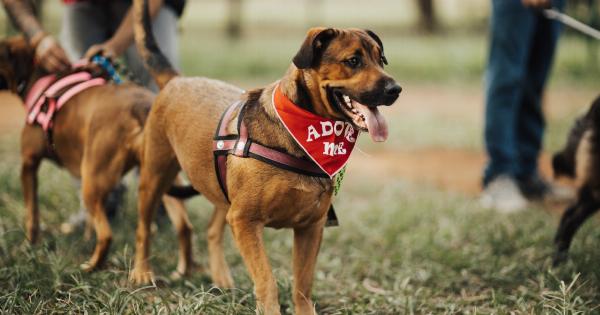Having a furry companion by your side can bring immense joy and happiness into your life. Dogs are known for their loyalty, love, and trust towards their owners.
However, to truly understand and connect with our canine friends, it is crucial to comprehend their signals accurately. Dogs communicate with us through their body language, vocalizations, and overall behavior. By learning and interpreting these signals effectively, we can strengthen our bond with them, enhance communication, and ensure their overall well-being.
The importance of understanding dog behavior
Dogs are fascinating creatures with a complex range of emotions and behaviors. Understanding their behavior is essential for several reasons:.
1. Strengthening the bond
When we can accurately interpret our dog’s signals, we build trust and rapport with them. By understanding what they are trying to convey, we can respond appropriately and address their needs.
This strengthens the bond between human and canine, leading to a more harmonious relationship.
2. Identifying stress and anxiety
Dogs may express their stress or anxiety through specific signals. These can include pacing, panting excessively, drooling, or destructive behaviors. By recognizing these signs, we can alleviate their distress and provide a comforting environment.
3. Promoting safety
Understanding dog behavior helps us recognize when our canine companions are feeling threatened or fearful.
By identifying these cues, we can prevent potential situations that may escalate into aggression or harm, both for the dog and those around them.
4. Effective training
Training a dog becomes much more successful when we can accurately read their body language and respond accordingly. By understanding their signals, we can communicate more effectively and train them in a positive, reinforcing manner.
Interpreting dog body language
One of the most crucial aspects of understanding our dogs is learning how to interpret their body language. Here are some key signals to look out for:.
1. Tail position and movement
The position and movement of a dog’s tail can tell us a lot about their current emotional state. A relaxed, wagging tail typically indicates happiness and friendliness.
However, a tucked tail or a stiffly raised tail could suggest fear or aggression.
2. Ear position
The positioning of a dog’s ears is another important indicator. Erect, forward-facing ears often mean the dog is alert and interested. Conversely, flattened ears can signal fear or submission.
3. Eye contact
Dogs use eye contact to communicate various messages. A soft, relaxed gaze usually means the dog is calm and comfortable. Avoiding eye contact or staring intensely may indicate fear, aggression, or a need for space.
4. Body posture
The overall body posture of a dog can convey many emotions. A relaxed, loose body signifies a calm and contented dog. On the other hand, a tense, rigid stance could indicate fear or aggression.
5. Vocalizations
While body language is the primary mode of communication for dogs, vocalizations also play a role. Barking can indicate excitement, fear, or a warning sign.
Whining is often a sign of distress, while growling is a clear indication of discomfort or aggression.
Common misconceptions about dog behavior
It is important to debunk some common misconceptions that pet owners may have about dog behavior:.
1. Wagging tail means a happy dog
While a wagging tail can indicate happiness, it is not always the case. A dog may wag its tail when feeling nervous, anxious, or even aggressive.
It is crucial to pay attention to the context and other body language signals to accurately understand their emotions.
2. A dog that licks is always showing affection
Dogs may lick for various reasons, and it is not always a display of affection. Licking can be a sign of submission, anxiety, or even a health issue. Understanding the context and accompanying signals is vital in interpreting this behavior accurately.
3. A wagging tail means a dog is friendly to approach
While a loose, relaxed wagging tail often indicates friendliness, it is essential to assess the entire body language before approaching a dog. A wagging tail alongside other tense body postures can signify caution or potential aggression.
Approachability should always be evaluated holistically.
Improving your understanding of dog signals
To accurately comprehend your dog’s signals, consider the following tips:.
1. Educate yourself
Learn about dog behavior, body language, and vocal communication through books, online resources, or professional guidance. The more knowledge you have, the better equipped you will be to understand your furry friend.
2. Observe your dog
Take the time to observe your dog in various situations. Pay attention to their body language, facial expressions, tail movements, and vocalizations. Understanding their unique signals will help you establish a stronger connection.
3. Seek professional guidance
If you’re struggling to interpret your dog’s signals accurately, consider seeking guidance from a professional dog trainer or behaviorist.
They can provide valuable insights and personalized advice to improve your understanding and communication with your canine companion.
4. Be patient and empathetic
Remember that each dog is an individual with their own personality and preferences. Be patient and empathetic in your interactions with them, allowing them to express themselves in their unique way. Building trust takes time.
Conclusion
Understanding your dog’s signals accurately is essential for fostering a strong bond, promoting their well-being, and ensuring effective communication.
By interpreting their body language, vocalizations, and behavior, we can respond appropriately to their needs and emotions. Remember to educate yourself, observe your dog, and seek professional guidance if needed. By doing so, you will enhance your relationship with your furry friend and create a harmonious and fulfilling partnership.






























